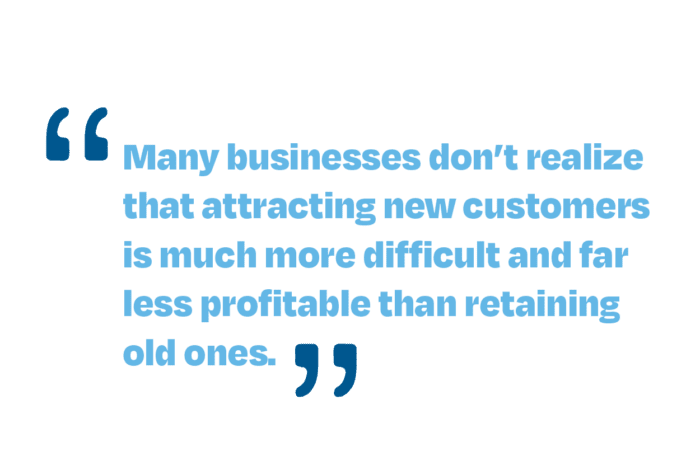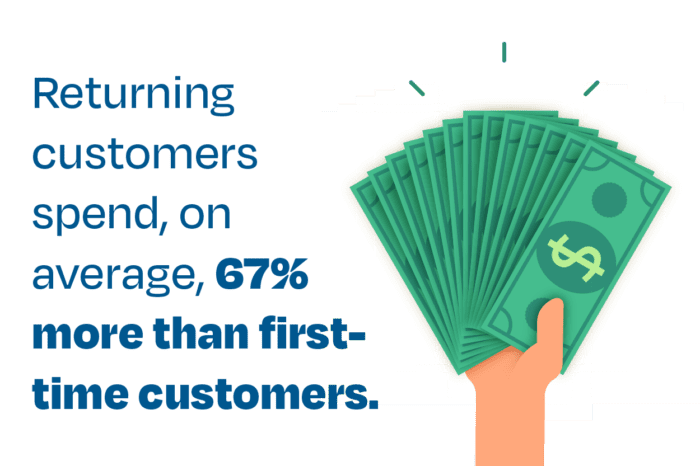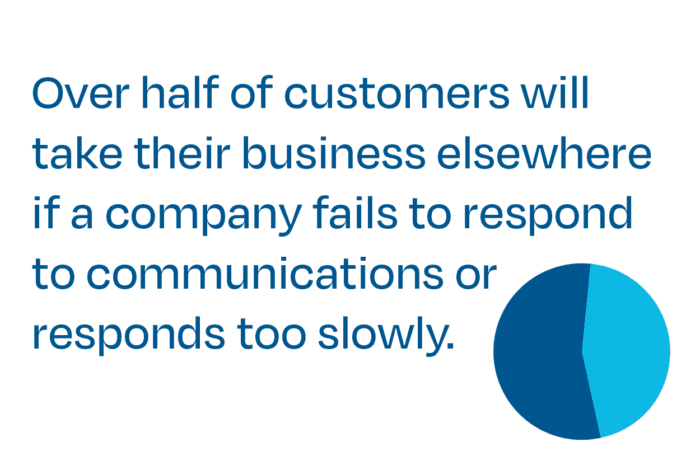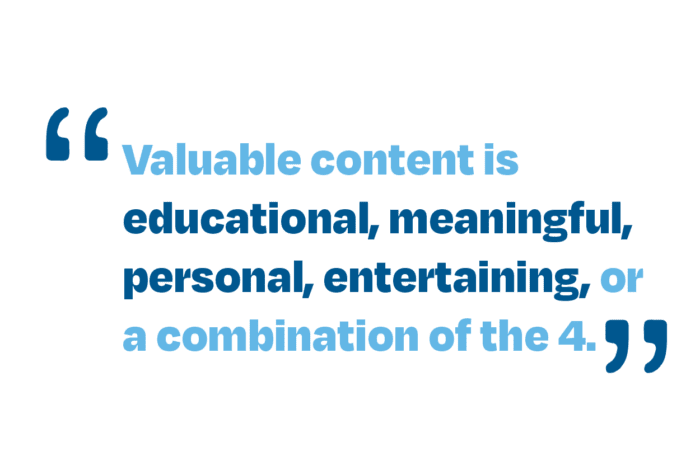Marketers often spend much time finding innovative strategies for attracting new customers to their business. However, marketers often exclude one critical demographic: current customers. That’s why it’s essential to understand what customer relationship marketing is, how to implement it in your business, and the long-term benefits of customer relationship marketing.

Let’s start with the basics.
What Is Customer Relationship Marketing?
MailChimp defines customer relationship marketing as “a strategy by which your team concentrates on building relationships with your patrons rather than on transactions.”
Or, when you focus on relationship marketing, you build a long-term connection with your customers. You’re not trying to influence a short-term, immediate sale.
When nurtured over time, these strong customer relationships can be fruitful. In fact, the benefits of customer relationship marketing often outweigh the benefits of attracting new leads. Here are a few things businesses can gain from investing in relationship marketing.
The Benefits Of Customer Relationship Marketing
The unique benefits of customer relationship marketing are numerous. However, we will only cover 5 of the most notable here, starting with retention.
Retention Rates
Boosting retention is an often-neglected area of focus for many businesses. Less than 2 out of every 10 businesses report they devote substantial attention to improving their retention rates. Contrastingly, 44% report they spend a significant amount of time dedicated to attracting first-time customers.
But is reaching out to new customers the best use of your business’s resources?
Many businesses don’t realize that attracting new customers is much more difficult and far less profitable than retaining old ones. New customers cost more to obtain, spend less, and are much more likely to switch to a competitor.

However, your current customers are already familiar with your business and interested in what you offer. Focusing your efforts on retaining them can result in a massive boost in overall profits and ROI.
Here are a few key statistics demonstrating how critical retention is for businesses.
- Returning customers spend, on average, 67% more than first-time customers.
- From a mere 5% increase in retention, profits can be boosted massively (between 25%– 95%).
- Most of a company’s business (65%) can be attributed to returning customers.
- More than 8 in 10 businesses report attracting new customers is more expensive than retaining old ones.
- Attracting a new patron has been estimated to cost 5–10 times more than retaining a previous patron.

But what does that have to do with relationship marketing? Well, one of the benefits of customer relationship marketing is that it can significantly improve your overall customer retention. When you regularly invest time in communicating with clients and nurturing your relationships with them, you invest in their loyalty to your business. They will be much less likely to switch to competitors if they feel you value their business.
But what about the clients that have already left your business?
Reactivations
Reactivations (or attracting former customers back to your business) can be a great way to boost your business without reaching out to new customers unfamiliar with your offerings.
However, before discussing how relationship marketing can help you reactivate former customers, you need to understand why customers leave businesses in the first place.
- 7 out of 10 consumers stated they would stop doing business with a company that appeared to be apathetic.
- Most consumers (83%) report being willing to leave a business over poor customer service.
- Over half of customers will take their business elsewhere if a company fails to respond to communications or responds too slowly.
- Nearly a third of consumers report abandoning businesses simply because they want to try out the competition.

So, most customers leave businesses because they feel ignored or disrespected. Unfortunately, it is challenging to entice a customer to return after a bad experience.
That said, some customers fail to return to a business because they simply forget it exists. As shocking as that may sound to some business owners, it’s more common than you think. If your customers don’t hear from you for a while, they might not even remember your business’s name when it comes time to buy from someone in your industry.
Or perhaps they tried out a competitor they felt was more appreciative of their business and stayed with it. In that case, you might still be able to convince them to return.
One of the great benefits of customer relationship marketing is its ability to reattract old clients to your business. When you provide former customers with unexpected value, they are much more likely to consider returning. They also might be more willing to speak highly of your business to others, which leads us to our next point.
Word-Of-Mouth
One of the benefits of customer relationship marketing is that it keeps your brand top of mind with your audience. Clients who regularly positively interact with your brand will likely remember it favorably.
This heightened awareness often boosts word-of-mouth marketing for your business. Relationship marketing provides value for your audience beyond the mere value of your products and services. So, it’s common for clients to begin sharing the content or offers they find valuable with friends and family.
This usually results in more referrals for your business. After all, if customers think and talk about your business regularly, they will likely share that enthusiasm with friends and family. That’s why implementing a worthwhile referral program to reward clients who have become brand advocates for your business is vital.
Improved Engagement
Speaking of brand advocates, improved engagement is one of the key benefits of customer relationship marketing. Clients who find unique value in your business are much more likely to engage with your business in the future. They might even become “highly engaged” customers who can greatly boost your business.
Highly engaged customers are much more valuable on average than other customers. In fact, highly engaged customers have been shown to (on average):
- Buy 90% more frequently than your other customers
- Spend 60% more with every purchase
- Are much more likely (5 times more) than the average customer to report being very loyal to the business they are engaged with
Over a 12-month calendar year, this culminates in highly engaged customers providing businesses with 3 times more value than the average customer. Imagine the benefits your business could see if they converted even 2% of their current customers to highly engaged ones. The results would be staggering.
What if you could also convert leads you thought were a lost cause? That leads us right to our next point.
Sales
If you want to close more sales, relationship marketing can help in unexpected ways.
As you have probably noticed, some buyers are more decisive than others. Some are ready to close a deal within the first or second time speaking with a sales representative. Others might take months or even years.

However, most salespeople (94%) give up after their 4th call with a prospect. That’s especially concerning when you consider that it usually takes at least 5 follow-ups to close most sales (80%).
So, giving up entirely on your prospects is not a useful long-term strategy if you want to close more sales.
Here is where relationship marketing can benefit your prospects, not just your customers.
When you invest in building relationships, not profits, you create a sustainable reason for prospects to continue interacting with your business. Whether that comes from entertaining content, educational resources, or exclusive opportunities, they benefit from engaging with your business. They don’t have to buy from you to receive that value.
Over time, that can convert wary prospects into paying customers, even if it takes years. And even if they never convert, the effort you put into nurturing your leads might pay off in the form of prospects sharing your content with other potential customers.
But how do you build a relationship marketing strategy that will get results for your business?
How To Build Relationships With Your Audience
To see the benefits of customer relationship marketing, you will need to invest a substantial amount of time in nurturing your audience. Three of the easiest and most effective ways to do this are maintaining high customer service standards, rewarding customer loyalty, and consistently using content marketing to add value for your readers.
Let’s start with customer service.
Customer Service
Without excellent customer service, none of your other marketing measures will yield long-term results. That’s because customers are very sensitive to how they interact with businesses. Most are willing to switch to a competitor if they feel they were not treated well.
Here are just a few key statistics that reveal how essential providing excellent customer service is.
- More than 3 out of every 4 customers will permanently cease doing business with a company after just one bad experience.
- Nearly 7 in 10 customers are more likely to shop at stores with consistently excellent customer service.
- The vast majority of businesses (89%) acknowledge customer service is an essential concern if they want to retain customers.
But when it comes to customer relationship marketing, it’s not enough to simply provide “good” service. Your competitors are likely already doing that. No, you need to go above and beyond if you want to stand out.
You can boost your customer service standards in many ways, but they all stem from one key point: listening carefully. More often than not, if your business is doing something wrong in the customer service department, your clients will let you know. It’s essential to have a formal process for these complaints and to take them seriously so you can maintain an attitude of continuous improvement.
Once you receive feedback and tweak your standards accordingly, you must provide thorough employee training to clarify your expectations. Then, enforce them.
Beyond that, building relationships with your clients through customer service starts with adding a personal touch. Get to know your regulars’ names and preferences. Ensure your guests are greeted warmly when they enter your establishment. Consider offering refreshments or waiting-room entertainment if that makes sense for your industry.
Even better? Watch what your competitors are doing, then surpass that.
Loyalty Programs
Rewarding loyalty is part of letting your customers know you value their business. The following statistics reveal why a good rewards program is worth its weight in gold.
- 71% of customers report feeling rewards programs are essential to their business relationships.
- Most customers (68%) report preferring businesses with valuable loyalty programs.
- The vast majority of customers (91%) stated they are much more likely to purchase from brands that offer them tailored, relevant offers.
It makes sense if you think about it. After all, why would a customer continue doing business with you when they don’t feel like you appreciate their business?
The short answer is that they probably won’t.
That’s why it’s vital to set up a rewards program for your business with your specific customers in mind. Without one, you provide no long-term incentive for them to keep patronizing your business. This is especially true if your competitors offer more generous perks than you do.
Start by getting feedback from your clients on what they would find valuable in a rewards program. Then set up a system for tracking and distributing rewards and review it with your staff. Ensuring your rewards program is handled consistently is essential if you want to see results.
While you’re at it, consider setting up a system to reward referrals. Your customers feel appreciated when you acknowledge their contribution to your business, which reinforces the value they receive from doing so.
Content Marketing
The last method for relationship building is content marketing, which is our specialty. Content marketing (or distributing entertaining content to your audience) is a great way to provide value to your customers outside of your products and services.
But what does valuable content look like?
Valuable content is educational, meaningful, personal, entertaining, or a combination of the 4. It can come from stories, articles, graphics, videos, and more.

For example, when we create custom cover articles for our clients’ newsletters, we encourage them to share personal stories with their audience. This helps them build a personal connection between the reader and the business because they humanize the business owner. When clients relate to (or even feel friendly toward) the entrepreneurs who serve them, they are far less likely to switch to a competitor.
We also include other valuable content in our clients’ newsletters, like educational articles, recipes, and more. This variety of content is not always directly related to the business. However, it still caters to the particular needs and tastes of the customers. We often hear from our clients about how much their readers like the articles and how they feel more connected to them. Some even share the newsletters with friends and family. Some keep the issues on their coffee tables in their offices or at home.
You can distribute your content through other channels like social media, email marketing, and more. Almost any distribution method works as long as it reaches your audience, you send it out consistently, and it provides them with value.
By investing time in providing value for your audience, you will see the benefits of customer relationship marketing within your business, like significantly higher ROI, more profits, and less turnover.
Want to learn more about the importance of nurturing your audience through relationship marketing? Fill out the form below to download your free copy of our Nurture Report.


Recent Comments